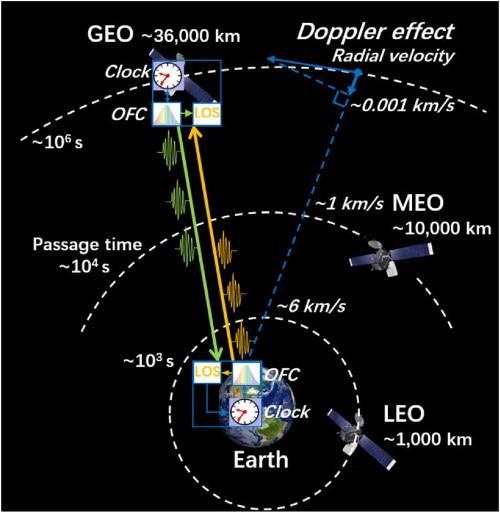Apr 26 2021
Researchers from the University of Science and Technology of China (USTC) of the Chinese Academy of Sciences analyzed the high-loss, free-space, high-precision time-frequency dissemination experiment between remote locations.
 Satellite–ground optical time-frequency dissemination diagram with different orbit types. Image Credit: Qi Shen et al.
Satellite–ground optical time-frequency dissemination diagram with different orbit types. Image Credit: Qi Shen et al.
Professor Jianwei Pan and his team from USTC thus simulated the high-precision, time-frequency, high-orbit satellite–ground links under the conditions of transmission delay, channel loss, and atmospheric noise.
The new link experiment shows that the instability of the time-frequency transfer through a satellite in middle to high earth orbits might reach 10−18 at 10,000 seconds, thereby facilitating intercontinental comparison of ground clocks and the potential performance of optical atomic clocks. The research has been published in the Optica journal.
High-precision, time-frequency dissemination and comparison methods apply to large-scale precision measurement systems of all types. The international metrology standard systems are now at the quantization stage.
The frequency standard forms the main aspect of the precision measurement and international metrology systems. Other fundamental physical quantities, apart from the amount of matter (mol), are indirectly or directly traced to the frequency.
By contrast, the new optical frequency standard technologies evolve quickly with an accuracy of two orders of magnitude more than that of the original “second” definition frequency standard.
The most crucial part in the technical framework of the change of the “second” definition is to fix the intercontinental time-frequency comparison with the optical frequency standard at the 10−18 level. Achieving an ultra-long-distance, high-precision time-frequency comparison or dissemination is an unsolved problem, whereas the satellite–ground link is identified as the most viable solution.
As part of this study, the team employed a dual-comb, linear optical sampling time measurement method. In contrast to the continuous-wave or single-photon link method, this complex link offers the benefit of high time resolution and a wide ambiguous range.
First, the team extensively investigated parameters like link-time asymmetry, satellite–ground link loss, atmosphere noise, and Doppler effect. The researchers identified that high-orbit links allow highly stable time-frequency comparison or dissemination by leveraging a large common view range, the long duration, and the lower relativistic effects.
The team then carried out a high-orbit satellite-ground time-frequency transmission experiment to mimic links with the delay effects, link loss, and atmospheric noise.
The researchers performed low-loss high-stability dual-comb interference optical path, low-noise optical comb amplification, and high-precision high-sensitivity linear sampling to create a 16-km horizontal atmospheric free space and high-precision dual-comb time-frequency transmission link in Shanghai.
The frequency transmission link could achieve an instability of 4 x 10−18 at 3,000 seconds with a link delay of 1 second and an average loss of 72 dB.
With these findings, the researchers predicted that the instability of the time-frequency transfer through a high-orbit satellite-ground link might reach 10−18 at 10,000 seconds.
Journal Reference:
Shen, Q., et al. (2021) Experimental simulation of time and frequency transfer via an optical satellite–ground link at 10−18 instability. Optica. doi.org/10.1364/OPTICA.413114.